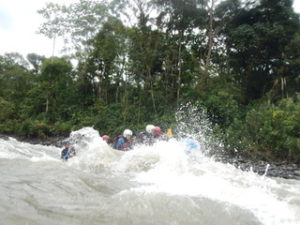
MidSummer Night’s Dream
Pursuing dreams often involve taking risks. What is thought of by night may turn into a jumble of emotions that focus on fears and demand courage by day.
Risky Business
Stacy Allison, the first American woman to reach the summit of Mt. Everest, relates stories of overcoming obstacles and the courage it took to pursue her dream through overwhelming negative odds. After years of work to get her body in shape and to find funding for the excursion, she was forced to abandon a her first half completed climb due to brutal weather. Stacy watched friends become seriously maimed and observed the ruthlessness of climbing a mountain that kills. Her experience at the higher reaches of Nepal was cold and miserable. Rather than give up, however, she grabbed at an opportunity a year later and this time was successful at reaching the pinnacle. Stacy’s experiences are well documented in her book, Many Mountains to Climb: Reflections on Competence, Courage, and Commitment. The motivational talks she gives are designed to inspire people to pursue their dreams, take risks, and not give up under challenging circumstances.
The amount of risk taking a individual should assume is difficult to assess. It is a personal decision that greatly affects how broadly one embraces their slice of life. Some people think that driving a car or walking across a busy street is enough of a risk in today’s crowded cities teaming with road rage. Parents, fearful of potential consequences, increasingly hover over their children to protect them from tumbles. Their anxiety, unfortunately, can affect the way their offspring navigate the world by making them cautious and restrained.
There are those, myself included, who have a need for adventure and are likely to reach out to embrace higher levels of unpredictability. At times it means that I put myself in harm’s way.
For the last two weeks I’ve been traveling through Ecuador, living with host families in the Amazon jungle and in highlands of the Andes Mountains. We river-rafted in the Amazon, horseback rode in areas adjacent to active volcanoes, zip-lined over high cliffs and climbed slippery waterfalls on narrow jungle trails while avoiding snakes, scorpions. and thorn bushes.
 While rafting, our cocky guide toppled five out of six participants (including himself) into churning waters when showing off by standing on the raft’s rim. Our lives were put at risk in a second of his madness as I was thrown into a whirlpool under the water’s surface. Wondering if I would rise to the top and be rescued before my breathe gave out, I could have drowned. . . but I didn’t. The experience was exhilarating and I can’t wait to go again. I was trained in survival techniques before the trip so was able to remain calm rather than panic as did several fellow rafters.
While rafting, our cocky guide toppled five out of six participants (including himself) into churning waters when showing off by standing on the raft’s rim. Our lives were put at risk in a second of his madness as I was thrown into a whirlpool under the water’s surface. Wondering if I would rise to the top and be rescued before my breathe gave out, I could have drowned. . . but I didn’t. The experience was exhilarating and I can’t wait to go again. I was trained in survival techniques before the trip so was able to remain calm rather than panic as did several fellow rafters.
But looking back, I realize that despite my daily fitness schedule, the strength I had as a youth is not there. I n acknowledge that risk-taking is relative to skill level, strength, and the ability to remain calm when stressed. A seventy-eight year old woman is not as agile or strong as the twenty year olds who filled the adjacent raft.
The young man my partner and I mentor is also a risk taker. He was fit with a good sense of balance and fearless. He worked hard by not always cautiously. Because he believed his life to be charmed and that he was above the possibility of a serious injury, instead of wearing his heavy safety-harness on lower-level scaffolding, he went without protection. His desire to move quickly, to be efficient, and to outshine other workers made him take risks. An accidental hit to his leg by a fellow painter sent him flying into permanent quadriplegic exile that now affects the entire family.
How much risk taking is a good thing? Sitting in a chair and never leaving home would be quite limiting. Physical inactivity caries its share of risks including the possibility of high blood pressure, coronary heart disease, anxiety and depression. Idleness and lethargy have instigated major health problems worldwide.
How can the need for physical challenges be balanced with our desire for safety? Do we protect our children from climbing trees or walking ta mile to and from school rather than sitting on a bus? In many nations, children travel two to five miles by foot to get to school each day. Walking or bicycle riding were the norm when I was a child but at time traffic was not as congested and we never heard of kidnapping or sex abusers.
An article in the BC Medical Journal talks of the risk-benefit paradox of exercise. It says that a certain amount is good and life giving while prolonged strenuous exercise training is associated with the risk of sudden cardiac death, atrial and ventricular arrhythmias and damage to muscles and bones.
How safe is safe enough in industrial settings, on children’s playgrounds, or in emerging technologies? The public ’s desire for a zero-risk society is threatening to political, economic, and personal expression. Our liturgical society has shifted risk away from individual responsibility. How do we set a balance for culpability? Some people crave more risky experiences than others. Is it in their DNA or part of their childhood exposures? If a person with Attention Deficit Disorder craves risk and acts without forethought who bears responsibility for the consequences of his or her action?
These questions are explored by many researchers and are difficult to assess. I can only speak for myself as a middle-of-the-road risk taker who tries to be prepared for an adventure that moves me a bit beyond my comfort zone. As a result, I have a rich variety of memories and experiences from having personal contacts with those living in other cultures. I’ve danced with tribal members in the streets of Kenya and in homes high in the Andes and learned about there views of family, politics, and religion. These excursions reinforce my belief that each person views the world in a unique way, yet are similar in their love of family, homeland, and a desire for peace and security.
References:
Risk of Physical Inactivity: http://www.hopkinsmedicine.org/healthlibrary/conditions/cardiovascular_diseasesrisks_of_physical_inactivity_85,P00218/
Warburton, Taunton, Bredin, Isserow, The BC Medical Journal, The risk-benefit paradox of exercise, Issue: BCMJ, Vol. 58, No. 4, May 2016, page(s) 210-218 Articles: http://www.bcmj.org/articles/risk-benefit-paradox-exercise.
